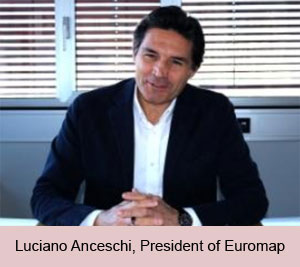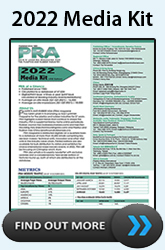China overtakes Europe in global machine exports; Germany in challenging times
Based on estimates, the global production of plastics and rubber machinery grew by 13% in 2021 and reached a new record level of EUR38.6 billion. China in particular stood out as a driver here, increasing its production by an above-average 15%, according to Euromap (European umbrella organisation of national plastics and rubber machine manufacturers).
European plastics and rubber machinery manufacturers achieved a slightly below-average increase of 11%, and now account for 40% of global production. Although this means they continue to hold the lion's share of global production, the figures also make it clear that the global plastics and rubber machinery sector has undergone a couple of shifts in recent years. In the past, the European share still accounted for almost 45%.
The fact that China exported the most plastics and rubber machinery for the first time last year also fits this picture. The Asian country increased its exports by an impressive 28.2% to EUR5.7 billion, thus relegating Germany to second place, and resulting in it having to relinquish its title of world export leader, with EUR5.2 billion (plus 9.4%).

"In the medium term, companies in Europe will have to prepare themselves for a significantly higher price level, as raw materials and energy in particular, have become much more expensive. At the same time, the situation in the supplier market is causing problems, plus, due to the increased uncertainty resulting from the war in Ukraine, processors are holding back on investments and therefore on new orders for machine manufacturers" stated Luciano Anceschi, President of Euromap, summing up the difficult situation.
"We have benefited from Covid, but now we have to brace ourselves for the fact that a saturation effect has occurred in large parts of our customer industries, and further growth will be difficult to achieve this year under the current conditions," Anceschi continues.
The European plastics and rubber machinery manufacturers are looking forward to the K trade fair in October, in order to be able to present the performance of their machines and their technical innovations to their customers, with a view to circular economy and digitalisation.
At K2022, Euromap will demonstrate the OPC UA technology and the specifications for digital interfaces already available for plastics and rubber machinery in action. Live data from connected machines can be accessed via an online dashboard by any trade fair visitor using a smartphone. Machine manufacturers worldwide can participate. This is aimed at making the great potential of platform-independent and manufacturer-independent machine-to-machine communication both visible and tangible.
Interoperability in production, i.e. the networking of all components within the production line, is considered a prerequisite for Industry 4.0. This gives machine operators the necessary access to production data, which allows them to monitor and control the processes for greater efficiency, traceability, condition monitoring through to machine learning, and artificial intelligence – and that in turn renders decisive competitive advantages for them.
The prerequisite for convenient "plug-and-play" networking is globally recognised, uniform standards for data exchange. The OPC UA standard as a global machine language is the perfect basis for the development of technical specifications for individual machines and components. After being initiated by VDMA and Euromap, the development of specifications is now taking place at a global level, together with the OPC Foundation and international partner associations.
German industry facing challenging times

Meanwhile, German plastics and rubber machinery manufacturers can look back on the year 2021 with satisfaction, achieving a turnover plus of 12%, according to Ulrich Reifenhäuser, Chairman of the Plastics and Rubber Machinery Association in the VDMA, summarising the situation.
"It didn't turn out to be a record year, as the impetus from the automotive sector in 2018 and 2019 was too strong for that, but we are more than satisfied with the order intake in 2021 as a whole (up 39% against the previous year)," Reifenhäuser continued.
Currently, the order books of companies are still reasonably well filled, but due to supply chain problems resulting from lockdowns and the Ukraine war, it is becoming increasingly difficult for companies to convert orders into turnover. Added to this are the rapidly rising prices for raw materials and energy. And finally, after the small interim peak in 2021, there is now a saturation effect in addition to a base effect. Both these factors mean that the new order volume is declining.
"In the first four months of the current year, new orders fell 17% short of those of the same period last year," says Thorsten Kühmann, managing director of the trade association, explaining the reason for the many worries among plastics and rubber machinery manufacturers.
"Availability of supplier parts is the predominant issue in the mechanical engineering sector, which, according to surveys, will become more acute again in the coming months before the sector can expect it to ease," Kühmann continues. The uncertainty in the world market as a result of the Ukraine war is doing the rest. For this reason, the trade association recently revised its turnover 2022 forecast of 5 to 10%, and now expects a sideways movement, or at best a small increase of no more than 2%.
Alongside climate protection and digitalisation, the circular economy is one of the key themes of K2022. If the plastics cycle is to be successful, recyclable products are needed, as well as high-performance machines and systems that can turn plastic waste into good quality recyclates, and then process the recyclates into new, high-quality products.
At the VDMA Circular Economy Forum on the open-air site of K 2022, visitors to the fair can see how the circular economy works in practice in the plastics industry. Throughout ten pavilions, the VDMA and its members – manufacturers of plastics machinery and equipment – together with their partners, will be showing the technologies they utilise to make the plastics cycle possible in the first place. This involves the processing of plastic waste, as well as the production of re-granulate, which is then processed into new products. The digitalisation of the procedures plays an important role here.
The VDMA Dome is at the centre of the forum. It is once again the meeting place for everyone who wants to know more about the circular economy in the world of plastics. The installation named "The Machine" provides an overview of the individual process steps of the cycle. Here, 40 companies will present their highlights on the circular economy in video clips.
(PRA)
Subscribe to Get the Latest Updates from PRA Please click here
©2022 Plastics and Rubber Asia. All rights reserved.

©2022 Plastics and Rubber Asia. All rights reserved.
Home Terms & Conditions Privacy Policy Webmail Site Map About Us



















